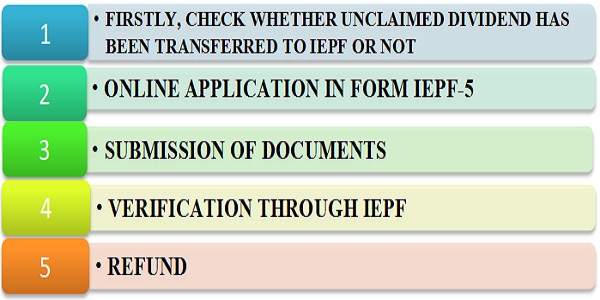In early days of investing in stocks, physical shares certificates were used to issue to an investors for their shares or debentures. Latterly in 1999, physical certificates were shifted to digital certificates by ‘Security & Exchange Board of India’ (SEBI) by introducing ‘Demat Account’. Due to the reform and new technology people face difficulties to transfer it digitally and many shares of different companies remain untransformed. According to Companies Act, 2013 when the shares or debentured remains unclaimed or unpaid for 7 years then it has to be transferred to the ‘Investor Education & Protection Fund’ (IEPF), which is managed by the Ministry of Corporate Affairs (MCA).
CATOGERIES OF RECOVERY:
1. Recovery of lost shares
2. Transfer of physical shares
3. Transfer of shares after death of shareholder
4. Issue of duplicate shares
5. The claim of unclaimed dividend for IEPF
WHAT IS IEPF?
IEPF stands for ‘Investor Education & Protection Fund’. It was established on 7th September, 2016, under the provision of section 125 of the companies Act, 2013. It makes refund of shares, unclaimed dividends, matured deposits and debentures etc. to investors. Its main purpose is to secure the interest of the investors. There shell be no suit or liability of authority or any officer for such act which is done by him under his duty in good faith.
Reasons for transfer:
There can be any reasons. For example-
I. Unawareness of the assets to legal heirs.
II. Lost or misplace
III. Death of the investor
IV. Forgotten ownership details
V. Unaware of technology and process
VI. Outdated bank account details
VII. Unaware of new rules, etc.
Composition of IEPF-
1) Chairperson
2) 6 Members
3) Chief Executive Office
It is the duty of authority and committees, which is constituted by the authority, to meet at least once in a quarter and at least 4 times in a financial year and to issue annual report.
KNOW-HOW PROCESS

1. CHECK WHETHER UNCLAIMED DIVIDEND HAS BEEN TRANSFERRED TO IEPF OR NOT: Firstly contact to ‘Nodal Officer IEPF’ of the company about the process of transfer. Contact of the Nodal Officer will be available on the website of the company. They will asked you about registered folio number and name of the investor as mentioned on the security documents and some other general details and will conformed you about the process of transfer through email.
2. ONLINE APPLICATION THROUGH IEPF-5 FORM: The form is needs to be filled through online mode. Formed filled in physical mode are summarily rejected. Form is available on the website of IEPF. After filling the form claimant has to take out the print of the form ‘IEPF-5’.
According to annual report of IEPF, 2021-2022 e-forms filed for IEPF-5 are as follows-

According to annual report of IEPF, 2021022- Number of application in which sanction for refund were made was 10, 472 and Number of application pending at the end of the year was 16,418. Balance available in the IEPF at the end of the year was Rs 5,26,225 lakh.
3. SUBMISSION OF DOCUMENTS: The claimant to submit print out of the IEPF-5 form along with Indemnity Bond (original), copy of the acknowledgement and other documents to Nodal Officer to registered office of the company for verification of the claim. Registered office of company means the company, whose securities the claimant holds and making the claim.
4. VERIFICATION THROUGH IEPF: After receiving the IEPF-5 and other documents, company will send the verification report to IEPF within 15 days of receipt of the claim. Then IEPF will examine completeness and genuineness of documents which company have transferred and will conform the claim.
5. REFUND: After examination of documents and claim, if they believes that it is genuine or original, IEPF transfer the shares and refund amount through electronic mode to the claimant in there bank account.
PERTICILERS OF IEPF-5 FORM:
- GENERAL-
| INDIVIDUAL | COMPANY | |
| A. | Name of Applicant | Corporate Identification Number(CIN)/ Bank Corporate Identification Number(BCIN) |
| B. | Address of Applicant | Name of the company |
| C. | Phone no. of Applicant | Address of the company |
| D. | Email ID of Applicant | Email ID of the company |
- DETAILS OF SHARE CLAIMED
a. Folio no.
b. Kinds of shares
c. Category
d. of shares
e. Total nominal amount of the shares
- Detailed Of Amount Claimed- Optional
- Aadhar No. / Passport/ OCI/ PIO Card No. (In Case Of Foreigners).
- Details of Bank Account in Which Refund of Claim to Be Made.
FREQUENTLY ASKED QUESTIONS
Q.1 What is Demat Account?
Demat Account is like a saving account but it used to hold shares and securities in electronic mode. You can open it by simply searching on Google ‘Open Demat Account’. To open a Demat account; firstly you have to choose Depository Participant.
Q.2 Who is Depository Participant?
Depository Participant is a mediator, act as a store of assets such as securities.
Q.3 Who can claim?
1. Investor
2. Nominee
3. Legal heirs
Q.4 Where can we fill IEPF-5 form online?
Through official website ‘www.iepf.gov.in
Q.5 Is there any fee for filing the form IEPF?
No, there is no fee for filing the form.
Q.6 What is the required value of the stamp paper for the indemnity bond?
In case of refund of dividend amount is –
i. Rs 10,000 or less, indemnity bond can be executed on a plain paper.
ii. More than Rs 10,000, non-judicial stamp paper of appropriate value as prescribed under Stamp Act.
Conclusion:
Recovering shares from IEPF involves a structured process to ensure rightful ownership. Understanding the categories of recovery, IEPF composition, and particulars of the IEPF-5 form are essential for a smooth recovery process. Stay informed and follow the guidelines to reclaim your shares efficiently.
*****
Disclaimer: The entire content of this article has been prepared based on relevant provisions and the information available at the time of preparation. While care has been taken to ensure the accuracy, completeness, and reliability of the information provided, the author assumes no responsibility for any errors or omissions. Users of this information agree that it is not professional advice and is subject to change without notice. The author assumes no responsibility for the consequences of using this information. IN NO EVENT SHALL THE AUTHOR BE LIABLE FOR ANY DIRECT, INDIRECT, SPECIAL, OR INCIDENTAL DAMAGE RESULTING FROM OR ARISING OUT OF OR IN CONNECTION WITH THE USE OF THIS INFORMATION.
The author, CS Monika Malhotra (Practicing Company Secretary), can be reached at csmonikamalhotra26@gmail.com or +91-9958089808.





